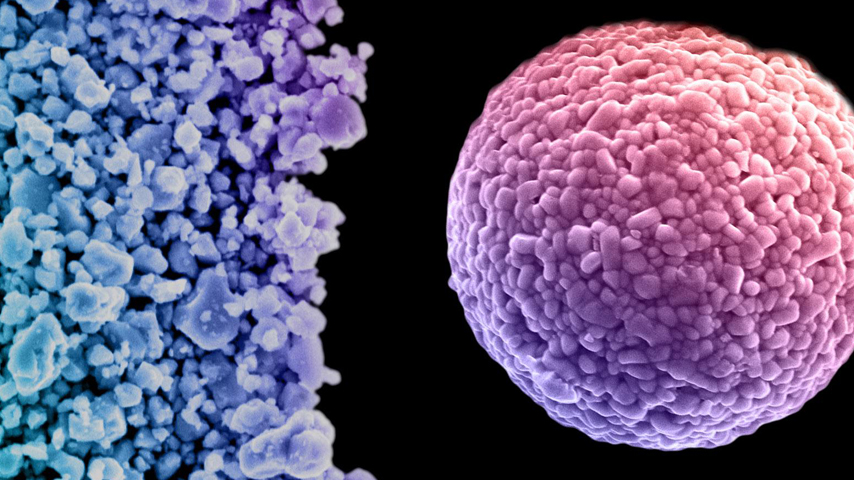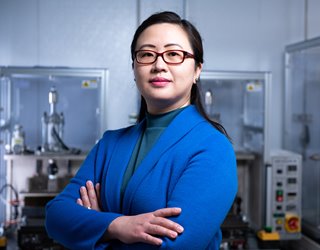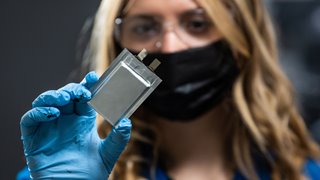Breakthrough Could Make for Long-Range EVs
Breakthrough Could Make for Long-Range EVs


Researchers at a national lab found a pathway to synthesize single-crystal, high-energy, nickel-rich cathodes.
A simple shift in lithium-ion battery manufacturing could pay big dividends, according to new research led by the Department of Energy’s Pacific Northwest National Laboratory in Richland, Wash. The researchers suggest that their solution could lead to electric vehicles that can store more energy per charge and withstand more charging cycles, which means longer-range and longer-lasting EVs.
An electric vehicle’s mileage range is a critical data point that promotes or delimits the vehicle’s time between charges. Much depends on the deliverable energy from each of the constituent cells of the vehicle’s battery pack. Lithium-ion is the predominant category of EV batteries, and the capacity of lithium-ion batteries is determined largely by their cell-level energy capacity and the economics of using such batteries. The positive pole of the battery, or its cathode, has been a targeted area to improve battery performance and assist in boosting the EV's range.
This was the impetus behind an innovative, cost-effective solution developed by the Pacific Northwest National Laboratory (PPNL). Partnering with the Charlotte, N.C.-based Albemarle Corporation, a specialist in energy storage technology, researchers at the lab found a pathway to synthesize single-crystal, high-energy, nickel-rich cathodes.
Jie Xiao is a Battelle Fellow for the battery materials and systems group at PNNL. She explains that there are advantages to using different materials to construct the cathodes they developed in research.
“Conventional cathodes in EV batteries use a cocktail of metal oxides. Lithium nickel manganese cobalt oxides, or NMC111, for instance, use 33 percent nickel, 33 percent manganese, and 33 percent cobalt,” Xiao said. “Increasing the proportion of nickel in this NMC cocktail greatly improves these batteries’ ability to store energy, increasing EV range.”
An example of this more nickel-rich material is LiNi0.8Mn0.1Co0.1O2 or so called NMC811. However, in the current state-of-art manufacturing process, NMC811 is formed into lumpy, agglomerated polycrystal structures that have numerous grain boundaries. Those “meatball” cracks along the grain boundaries lead to battery failure.
More on this topic: Solid-State Battery Technology
Increasing the proportion of nickel in these polycrystal structures makes things worse by triggering gas generation along those grain boundaries, increasing failure and decay rates.
NMC811 formed into individual, single-crystal crystal structures without any grain boundary would resolve this problem, Xiao said, allowing more nickel to be used without negative effects. However, producing single-crystal NMC811 has historically been a lab-based exercise that is expensive and impractical for mass production.
“In the past, we tried to enhance the stability of the conventional high-nickel NMC cathode (polycrystal NMC811) using doping or coating,” Xiao said. “A few years ago, we realized that the challenges associated with high-nickel NMC are rooted in their agglomerated structures and the grain boundaries that form within them. We hypothesized that if we could convert the polycrystal NMC into a single-crystal form, we could mitigate these issues and improve stability.”
That led the team to try a very different approach. “NMC cathodes are formed when the transition metal hydroxide reacts with lithium salt,” Xiao said. “PNNL researchers did not create a new cathode per se, but rather, discovered that pre-heating the transition metal hydroxide prior to mixing it with the lithium salt produces NMC with a reliably smooth, defect-free single-crystal structure.”
Xiao said the method is simple, cost-effective, and can easily be incorporated in existing battery production facilities and procedures. Even better, a cathode based on NMC811 provides around 30 percent more energy storage capacity compared to a cathode based on NMC111. “This has clear and substantial implications for the EV marketplace,” she said.
Check out the infographic: Battery Upgrades Unlocked
The team then discussed the idea with Albemarle and, together, presented the idea and concept to the DOE, which then offered full support to explore this question using Albemarle’s lithium salts.
Understanding cathode manufacturing better and discovering roadblocks to smoother and more efficient production, is key to an improved EV battery.
“My team at PNNL really enjoyed collaborating with Albemarle," Xiao said. “The collaboration generated significant momentum to further explore processes in battery materials manufacturing science. We look forward to continuing our work with industry partners to establish a robust domestic battery manufacturing and supply chain.”
Jim Romeo is a technology writer in Chesapeake, Va.
An electric vehicle’s mileage range is a critical data point that promotes or delimits the vehicle’s time between charges. Much depends on the deliverable energy from each of the constituent cells of the vehicle’s battery pack. Lithium-ion is the predominant category of EV batteries, and the capacity of lithium-ion batteries is determined largely by their cell-level energy capacity and the economics of using such batteries. The positive pole of the battery, or its cathode, has been a targeted area to improve battery performance and assist in boosting the EV's range.
This was the impetus behind an innovative, cost-effective solution developed by the Pacific Northwest National Laboratory (PPNL). Partnering with the Charlotte, N.C.-based Albemarle Corporation, a specialist in energy storage technology, researchers at the lab found a pathway to synthesize single-crystal, high-energy, nickel-rich cathodes.
Jie Xiao is a Battelle Fellow for the battery materials and systems group at PNNL. She explains that there are advantages to using different materials to construct the cathodes they developed in research.
“Conventional cathodes in EV batteries use a cocktail of metal oxides. Lithium nickel manganese cobalt oxides, or NMC111, for instance, use 33 percent nickel, 33 percent manganese, and 33 percent cobalt,” Xiao said. “Increasing the proportion of nickel in this NMC cocktail greatly improves these batteries’ ability to store energy, increasing EV range.”
An example of this more nickel-rich material is LiNi0.8Mn0.1Co0.1O2 or so called NMC811. However, in the current state-of-art manufacturing process, NMC811 is formed into lumpy, agglomerated polycrystal structures that have numerous grain boundaries. Those “meatball” cracks along the grain boundaries lead to battery failure.
More on this topic: Solid-State Battery Technology
Increasing the proportion of nickel in these polycrystal structures makes things worse by triggering gas generation along those grain boundaries, increasing failure and decay rates.
NMC811 formed into individual, single-crystal crystal structures without any grain boundary would resolve this problem, Xiao said, allowing more nickel to be used without negative effects. However, producing single-crystal NMC811 has historically been a lab-based exercise that is expensive and impractical for mass production.
“In the past, we tried to enhance the stability of the conventional high-nickel NMC cathode (polycrystal NMC811) using doping or coating,” Xiao said. “A few years ago, we realized that the challenges associated with high-nickel NMC are rooted in their agglomerated structures and the grain boundaries that form within them. We hypothesized that if we could convert the polycrystal NMC into a single-crystal form, we could mitigate these issues and improve stability.”
That led the team to try a very different approach. “NMC cathodes are formed when the transition metal hydroxide reacts with lithium salt,” Xiao said. “PNNL researchers did not create a new cathode per se, but rather, discovered that pre-heating the transition metal hydroxide prior to mixing it with the lithium salt produces NMC with a reliably smooth, defect-free single-crystal structure.”
Xiao said the method is simple, cost-effective, and can easily be incorporated in existing battery production facilities and procedures. Even better, a cathode based on NMC811 provides around 30 percent more energy storage capacity compared to a cathode based on NMC111. “This has clear and substantial implications for the EV marketplace,” she said.
The road to a better cathode
The discovery in a better polycrystal came about with U.S. Department of Energy (DOE) funding and a recent conclusion reached from prior research which showed that cracks found in single-crystal cathode materials was reversible, Xiao said. “We started to ask ourselves: Could we develop a cost-effective, solid-state approach to scaling up high-nickel cathodes, allowing industry to adopt them without needing to change the manufacturing facility?”Check out the infographic: Battery Upgrades Unlocked
The team then discussed the idea with Albemarle and, together, presented the idea and concept to the DOE, which then offered full support to explore this question using Albemarle’s lithium salts.
Understanding cathode manufacturing better and discovering roadblocks to smoother and more efficient production, is key to an improved EV battery.
“My team at PNNL really enjoyed collaborating with Albemarle," Xiao said. “The collaboration generated significant momentum to further explore processes in battery materials manufacturing science. We look forward to continuing our work with industry partners to establish a robust domestic battery manufacturing and supply chain.”
Jim Romeo is a technology writer in Chesapeake, Va.







